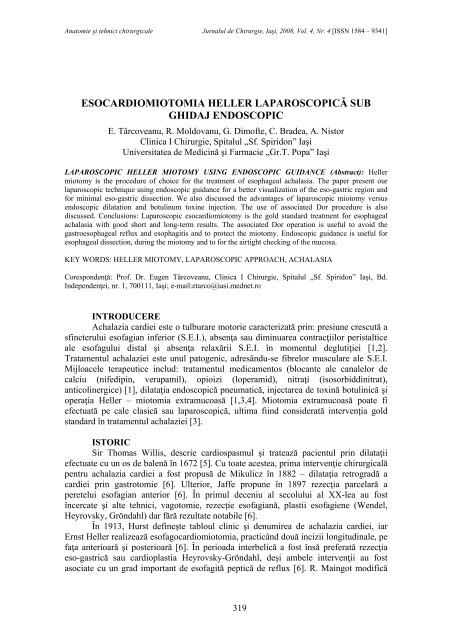Full text PDF (6.1 MB) - Jurnalul de Chirurgie
Full text PDF (6.1 MB) - Jurnalul de Chirurgie
Full text PDF (6.1 MB) - Jurnalul de Chirurgie
Create successful ePaper yourself
Turn your PDF publications into a flip-book with our unique Google optimized e-Paper software.
Anatomie şi tehnici chirurgicale <strong>Jurnalul</strong> <strong>de</strong> <strong>Chirurgie</strong>, Iaşi, 2008, Vol. 4, Nr. 4 [ISSN 1584 – 9341]<br />
ESOCARDIOMIOTOMIA HELLER LAPAROSCOPICĂ SUB<br />
GHIDAJ ENDOSCOPIC<br />
E. Târcoveanu, R. Moldovanu, G. Dimofte, C. Bra<strong>de</strong>a, A. Nistor<br />
Clinica I <strong>Chirurgie</strong>, Spitalul „Sf. Spiridon” Iaşi<br />
Universitatea <strong>de</strong> Medicină şi Farmacie „Gr.T. Popa” Iaşi<br />
LAPAROSCOPIC HELLER MIOTOMY USING ENDOSCOPIC GUIDANCE (Abstract): Heller<br />
miotomy is the procedure of choice for the treatment of esophageal achalasia. The paper present our<br />
laparoscopic technique using endoscopic guidance for a better visualization of the eso-gastric region and<br />
for minimal eso-gastric dissection. We also discussed the advantages of laparoscopic miotomy versus<br />
endoscopic dilatation and botulinum toxine injection. The use of associated Dor procedure is also<br />
discussed. Conclusions: Laparoscopic esocardiomiotomy is the gold standard treatment for esophageal<br />
achalasia with good short and long-term results. The associated Dor operation is useful to avoid the<br />
gastroesophageal reflux and esophagitis and to protect the miotomy. Endoscopic guidance is useful for<br />
esophageal dissection, during the miotomy and to for the airtight checking of the mucosa.<br />
KEY WORDS: HELLER MIOTOMY, LAPAROSCOPIC APPROACH, ACHALASIA<br />
Corespon<strong>de</strong>nţă: Prof. Dr. Eugen Târcoveanu, Clinica I <strong>Chirurgie</strong>, Spitalul „Sf. Spiridon” Iaşi, Bd.<br />
In<strong>de</strong>pen<strong>de</strong>nţei, nr. 1, 700111, Iaşi; e-mail:etarco@iasi.mednet.ro<br />
INTRODUCERE<br />
Achalazia cardiei este o tulburare motorie caracterizată prin: presiune crescută a<br />
sfincterului esofagian inferior (S.E.I.), absenţa sau diminuarea contracţiilor peristaltice<br />
ale esofagului distal şi absenţa relaxării S.E.I. în momentul <strong>de</strong>glutiţiei [1,2].<br />
Tratamentul achalaziei este unul patogenic, adresându-se fibrelor musculare ale S.E.I.<br />
Mijloacele terapeutice includ: tratamentul medicamentos (blocante ale canalelor <strong>de</strong><br />
calciu (nifedipin, verapamil), opioizi (loperamid), nitraţi (isosorbiddinitrat),<br />
anticolinergice) [1], dilataţia endoscopică pneumatică, injectarea <strong>de</strong> toxină botulinică şi<br />
operaţia Heller – miotomia extramucoasă [1,3,4]. Miotomia extramucoasă poate fi<br />
efectuată pe cale clasică sau laparoscopică, ultima fiind consi<strong>de</strong>rată intervenţia gold<br />
standard în tratamentul achalaziei [3].<br />
ISTORIC<br />
Sir Thomas Willis, <strong>de</strong>scrie cardiospasmul şi tratează pacientul prin dilataţii<br />
efectuate cu un os <strong>de</strong> balenă în 1672 [5]. Cu toate acestea, prima intervenţie chirurgicală<br />
pentru achalazia cardiei a fost propusă <strong>de</strong> Mikulicz în 1882 – dilataţia retrogradă a<br />
cardiei prin gastrotomie [6]. Ulterior, Jaffe propune în 1897 rezecţia parcelară a<br />
peretelui esofagian anterior [6]. În primul <strong>de</strong>ceniu al secolului al XX-lea au fost<br />
încercate şi alte tehnici, vagotomie, rezecţie esofagiană, plastii esofagiene (Wen<strong>de</strong>l,<br />
Heyrovsky, Gröndahl) dar fără rezultate notabile [6].<br />
În 1913, Hurst <strong>de</strong>fineşte tabloul clinic şi <strong>de</strong>numirea <strong>de</strong> achalazia cardiei, iar<br />
Ernst Heller realizează esofagocardiomiotomia, practicând două incizii longitudinale, pe<br />
faţa anterioară şi posterioară [6]. În perioada interbelică a fost însă preferată rezecţia<br />
eso-gastrică sau cardioplastia Heyrovsky-Gröndahl, <strong>de</strong>şi ambele intervenţii au fost<br />
asociate cu un grad important <strong>de</strong> esofagită peptică <strong>de</strong> reflux [6]. R. Maingot modifică<br />
319

















